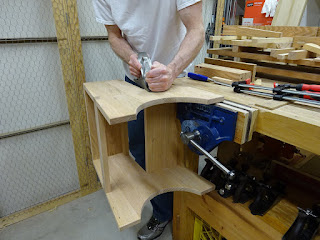I don't normally do prototypes of the things I build. But I got some pine boards in the load of oak I got from my neighbor's kitchen demolition. And it was just enough to make a full-sized prototype of the two-step stool.
 |
| Some of the wood that came out of my neighbor's old kitchen |
Last time I wrote about some design considerations and settled on this design.
 |
| The not-quite-final design |
I didn't bother taking any construction pics, as this was just a prototype. But here are some finished pics, showing some of the design features.
 |
| Steps are at 9" and 18" heights |
 |
| Back edge is angled for stability (wider at bottom) |
 |
| Front edge has matching angle for looks |
 |
| The steps are 15" long - plenty of room for two feet |
 |
| The lower step is just under 7" deep ... |
 |
| ... while the upper step is just under 6" deep |
I had intended for the two steps to be the same depth. But the way I laid this out, it didn't quite work out right - I'll fix that in the final version.
 |
| The cut-out in the sides that creates the feet is 10" wide, 3 1/2" high |
 |
| That leaves 4 3/4" of wood connecting the back of the stool to the front of the stool |
Besides the two steps that are dovetailed into the sides, there are three rails that connect the sides. There is one under the front of each step and one in the back.
 |
| Cross-rail half-dovetailed into the sides - also glued to the underside of the step |
 |
| Cross-rail in the back, fully dovetailed into the sides |
 |
| And here's the final piece |
I know it's just a prototype, but I finish planed all surfaces before final glue-up, cleaned up the dovetails and later (after the above picture) gave it three coats of shellac. I also planed smooth all the joints and rounded corners. I can't help myself.
I did learn a couple things. First, I'll adjust the final design so that the two steps are the same depth. The second thing has to do with the construction. When I fitted the cross rails, I took the baseline directly from the partially-assembled stool (the dovetailed steps were already in place). Thinking back on it, I should have put my two steps and three rails together and marked them for their baselines at one time. As it was, the rail baselines were a bit wider than the step dovetail baselines.
Lastly, these dovetails came out as good as any I've ever done. I was very careful to check that I sawed the tails perpendicular to the board's surface, and adjusted with a chisel when I didn't. This gave me a better "template" to transfer the outline of the tails to the pin board. They fit fairly well off the saw, with only a bit of adjusting needed. Let's see if I can do as well in oak!
The step stool is rock solid! Next post I should have the "real" one finished.






































